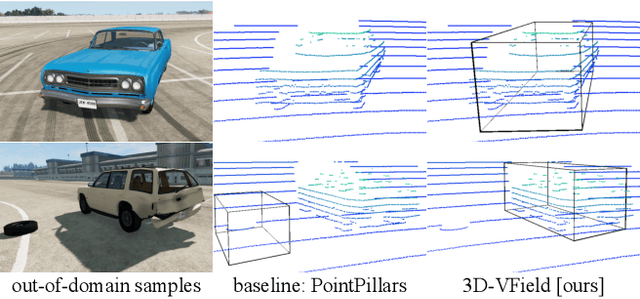Alexander Lehner
3D Adversarial Augmentations for Robust Out-of-Domain Predictions
Aug 29, 2023Abstract:Since real-world training datasets cannot properly sample the long tail of the underlying data distribution, corner cases and rare out-of-domain samples can severely hinder the performance of state-of-the-art models. This problem becomes even more severe for dense tasks, such as 3D semantic segmentation, where points of non-standard objects can be confidently associated to the wrong class. In this work, we focus on improving the generalization to out-of-domain data. We achieve this by augmenting the training set with adversarial examples. First, we learn a set of vectors that deform the objects in an adversarial fashion. To prevent the adversarial examples from being too far from the existing data distribution, we preserve their plausibility through a series of constraints, ensuring sensor-awareness and shapes smoothness. Then, we perform adversarial augmentation by applying the learned sample-independent vectors to the available objects when training a model. We conduct extensive experiments across a variety of scenarios on data from KITTI, Waymo, and CrashD for 3D object detection, and on data from SemanticKITTI, Waymo, and nuScenes for 3D semantic segmentation. Despite training on a standard single dataset, our approach substantially improves the robustness and generalization of both 3D object detection and 3D semantic segmentation methods to out-of-domain data.
3D-VField: Learning to Adversarially Deform Point Clouds for Robust 3D Object Detection
Dec 09, 2021



Abstract:As 3D object detection on point clouds relies on the geometrical relationships between the points, non-standard object shapes can hinder a method's detection capability. However, in safety-critical settings, robustness on out-of-distribution and long-tail samples is fundamental to circumvent dangerous issues, such as the misdetection of damaged or rare cars. In this work, we substantially improve the generalization of 3D object detectors to out-of-domain data by taking into account deformed point clouds during training. We achieve this with 3D-VField: a novel method that plausibly deforms objects via vectors learned in an adversarial fashion. Our approach constrains 3D points to slide along their sensor view rays while neither adding nor removing any of them. The obtained vectors are transferrable, sample-independent and preserve shape smoothness and occlusions. By augmenting normal samples with the deformations produced by these vector fields during training, we significantly improve robustness against differently shaped objects, such as damaged/deformed cars, even while training only on KITTI. Towards this end, we propose and share open source CrashD: a synthetic dataset of realistic damaged and rare cars, with a variety of crash scenarios. Extensive experiments on KITTI, Waymo, our CrashD and SUN RGB-D show the high generalizability of our techniques to out-of-domain data, different models and sensors, namely LiDAR and ToF cameras, for both indoor and outdoor scenes. Our CrashD dataset is available at https://crashd-cars.github.io.
 Add to Chrome
Add to Chrome Add to Firefox
Add to Firefox Add to Edge
Add to Edge